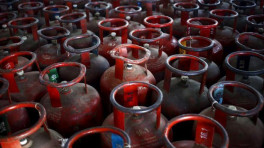Ctg port still grappling with container backlog
Port officials say the congestion is delaying the handling of import and export cargo

Despite slight improvements, container congestion continues to disrupt operations at Chattogram Port, with an unusually high number of containers crowding its yard and private inland container depots (ICDs), following the recent political upheavals and devastating floods.
Port officials say the congestion is delaying the handling of import and export cargo.
Although vessel waiting times at the port have improved, dropping from nine days to four-five days at the outer anchorage, pressure on the port's yards and depots remains high, they say.
According to the officials, at least 5,000 TEUs (Twenty-foot Equivalent Units) of import containers need to be cleared to restore normal operations of the port. Likewise, the depots must reduce their load by 5,000 TEUs of export containers.
Full normalisation is expected to take more than 15 days, they added.
Md Omar Faruk, secretary of the Chattogram Port Authority (CPA), said the situation is gradually improving as importers continue to collect their containers.
Container capacity and congestion levels
The Chattogram Port has a container capacity of 53,518 TEUs. For smooth operations, port authorities aim to keep the number of containers between 30,000 TEUs and 32,000 TEUs. As of 15 July, the port had 32,957 TEUs, which was considered manageable, according to the CPA.
Due to disruptions, including political unrest and the flood-related shutdown of the Dhaka-Chattogram highway and rail connections, container deliveries were halted, causing an accumulation of over 44,000 TEUs in the port yard by mid-August.
By 6 September, the number decreased to 40,180 TEUs, but officials still find this unsatisfactory.
They warn that unless deliveries exceed the rate of incoming import containers, the congestion will persist.
On 6 September, 4,315 TEUs were delivered, and 4,067 TEUs were cleared the day before. The port typically delivers 3,500 to 4,000 TEUs daily.
Decline in container handling and vessels arrivals
The overall volume of container handling at the port has also declined in recent months.
In June 2024, 328 vessels arrived at the Chattogram Port, followed by 315 vessels in July and 304 in August. By comparison, the highest number of vessel arrivals this year was in April, with 329 vessels.
Container handling has similarly decreased, with 319,193 TEUs cleared in May 2024, followed by a decline to 274,773 TEUs in June, 271,335 TEUs in July, and 271,869 TEUs in August.
The port handles both full and empty containers arriving and departing on vessels. This total handling includes import and export containers, as well as empties, from the Chattogram Port Yard, Dhaka ICD, and Pangaon ICD.
Pressure on export cargo at depots
Meanwhile, export cargo from various parts of the country is stored at 19 depots in Chattogram before shipment.
These depots typically handle around 8,000 TEUs daily, but this figure doubled in August. However, traffic was halted for a week due to flooding, causing the number of export containers at the depots to fall back to 8,000 TEUs by the end of August.
Ruhul Amin Shikder, secretary general of the Bangladesh Inland Container Depots Association (Bicda), the depots are now handling around 13,000 TEUs of export cargo, which is around 5,000 TEUs more than the usual.
"However, shipments from the depot to the port are proceeding normally, with more than 2,000 TEUs of export cargo being loaded onto container ships daily," he told TBS.
As of 4 September, there were 48,500 TEUs of empty containers and 7,315 TEUs of imported containers at the depots, he added.
Vessel congestion eases, but delays persist
For the past month and a half, vessels at the Chattogram Port have been facing extended delays, spending more than five days at the jetty instead of the usual two to three days for unloading and loading.
The delay has been caused by a lack of space in the port yard, leading to a backlog of vessels at the outer anchorage. At its peak, at least 18 vessels were waiting to enter the jetty.
Muntasir Rubayat, assistant vice president of GBX Logistics, said container congestion at the port reached critical levels after 19 July.
He said reduced storage space in the yard had slowed the loading of containers onto ships, significantly extending their time at the jetty.
"Vessels that typically docked within two days after arriving at the outer anchorage were forced to wait up to nine days during this period," he added.
According to the Chattogram Port berthing report on 5 September, there were seven container vessels still waiting outside the jetty, one of which had been anchored since 31 August and berthed only on 6 September, after a five-day wait.
However, port officials have stated that the waiting time for ships is now returning to normal levels.


 Keep updated, follow The Business Standard's Google news channel
Keep updated, follow The Business Standard's Google news channel















